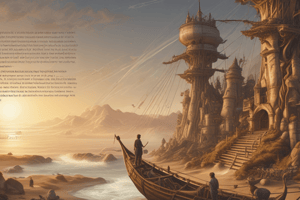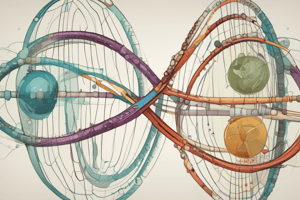Podcast
Questions and Answers
What is the primary cause of compasses pointing north?
What is the primary cause of compasses pointing north?
- The sun's atmosphere
- Solar winds
- The moon's gravitational pull
- Earth's magnetic field (correct)
What is the source of solar wind?
What is the source of solar wind?
- Moon's surface
- Photosphere
- Chromosphere
- Corona (correct)
What causes the moon to be visible from Earth?
What causes the moon to be visible from Earth?
- Solar winds
- Internal luminosity
- Earth's magnetic field
- Reflected sunlight (correct)
Which moon cycle comes after the waxing crescent?
Which moon cycle comes after the waxing crescent?
What caused the formation of the moon according to the Condensation Theory?
What caused the formation of the moon according to the Condensation Theory?
Which planet has a retrograde rotation?
Which planet has a retrograde rotation?
What are the characteristics of Venus's atmosphere?
What are the characteristics of Venus's atmosphere?
Which planet has evidence of past water?
Which planet has evidence of past water?
What are the components of the Solar System?
What are the components of the Solar System?
What are comets composed of?
What are comets composed of?
What is the distinguishing feature of a dwarf planet?
What is the distinguishing feature of a dwarf planet?
Which are the Galilean moons of Jupiter?
Which are the Galilean moons of Jupiter?
Which are the gas giants in the Solar System?
Which are the gas giants in the Solar System?
What are the characteristics of terrestrial planets?
What are the characteristics of terrestrial planets?
What is retrograde motion in planetary terms?
What is retrograde motion in planetary terms?
What is the primary cause of compasses pointing north?
What is the primary cause of compasses pointing north?
What is the visible surface of the sun called?
What is the visible surface of the sun called?
What causes the moon to be visible from Earth?
What causes the moon to be visible from Earth?
What are the moon cycles in the correct order?
What are the moon cycles in the correct order?
What is the composition of Jovian planets?
What is the composition of Jovian planets?
What are the Galilean moons of Jupiter?
What are the Galilean moons of Jupiter?
What is the evidence of volcanic activity on Venus?
What is the evidence of volcanic activity on Venus?
What is the size comparison between Mars and Earth?
What is the size comparison between Mars and Earth?
What are the characteristics of asteroids?
What are the characteristics of asteroids?
What is the primary difference between planets and dwarf planets?
What is the primary difference between planets and dwarf planets?
What is the composition of the moon's surface features Maria and Highlands?
What is the composition of the moon's surface features Maria and Highlands?
What are comets composed of?
What are comets composed of?
What is the characteristic of terrestrial planets?
What is the characteristic of terrestrial planets?
What is the definition of prograde motion in planetary terms?
What is the definition of prograde motion in planetary terms?
What are meteorites?
What are meteorites?
Flashcards are hidden until you start studying
Study Notes
Planetary Bodies and Solar System Components
- Moon cycles include new moon, waxing crescent, first quarter, waxing gibbous, and full moon, with surface features such as Maria and Highlands.
- The moon was formed after an impact on Earth by a protostar named Theia, leading to the Condensation Theory.
- Venus rotates retrograde, has evidence of volcanic activity, temperatures of 450 degrees Celsius, a CO2 atmosphere, and a rigid crust.
- Mars, the red planet, is cold and dry, with extreme and longer seasons, half the size of Earth, and evidence of past water.
- The Solar System components include planets, asteroids, moons, dwarf planets, and comets.
- Asteroids are rocky or metallic objects larger than 100m across, while comets are composed of nucleus and some have a tail.
- Meteoroids are small, less than 1m across, meteors are the bright trail left behind, and meteorites are rocks from space that fall through Earth's atmosphere.
- Planets orbit the sun, are spherical, and have cleared their orbit, while dwarf planets have only orbited the sun and are spherical.
- Jupiter's moons, the Galilean moons, include Ganymede, Europa, Io, and Callisto, each with distinct characteristics.
- The Solar System has gas giants (Jupiter and Saturn) and ice giants (Neptune and Uranus).
- Terrestrial planets are inner planets with a composition of rock or iron, while Jovian planets are outer planets composed primarily of hydrogen and helium.
- Prograde motion is when the object spins in the same direction as its orbit, while retrograde motion is the opposite, and most planets have prograde motion.
Planetary Bodies and Solar System Components
- Moon cycles include new moon, waxing crescent, first quarter, waxing gibbous, and full moon, with surface features such as Maria and Highlands.
- The moon was formed after an impact on Earth by a protostar named Theia, leading to the Condensation Theory.
- Venus rotates retrograde, has evidence of volcanic activity, temperatures of 450 degrees Celsius, a CO2 atmosphere, and a rigid crust.
- Mars, the red planet, is cold and dry, with extreme and longer seasons, half the size of Earth, and evidence of past water.
- The Solar System components include planets, asteroids, moons, dwarf planets, and comets.
- Asteroids are rocky or metallic objects larger than 100m across, while comets are composed of nucleus and some have a tail.
- Meteoroids are small, less than 1m across, meteors are the bright trail left behind, and meteorites are rocks from space that fall through Earth's atmosphere.
- Planets orbit the sun, are spherical, and have cleared their orbit, while dwarf planets have only orbited the sun and are spherical.
- Jupiter's moons, the Galilean moons, include Ganymede, Europa, Io, and Callisto, each with distinct characteristics.
- The Solar System has gas giants (Jupiter and Saturn) and ice giants (Neptune and Uranus).
- Terrestrial planets are inner planets with a composition of rock or iron, while Jovian planets are outer planets composed primarily of hydrogen and helium.
- Prograde motion is when the object spins in the same direction as its orbit, while retrograde motion is the opposite, and most planets have prograde motion.
Studying That Suits You
Use AI to generate personalized quizzes and flashcards to suit your learning preferences.




